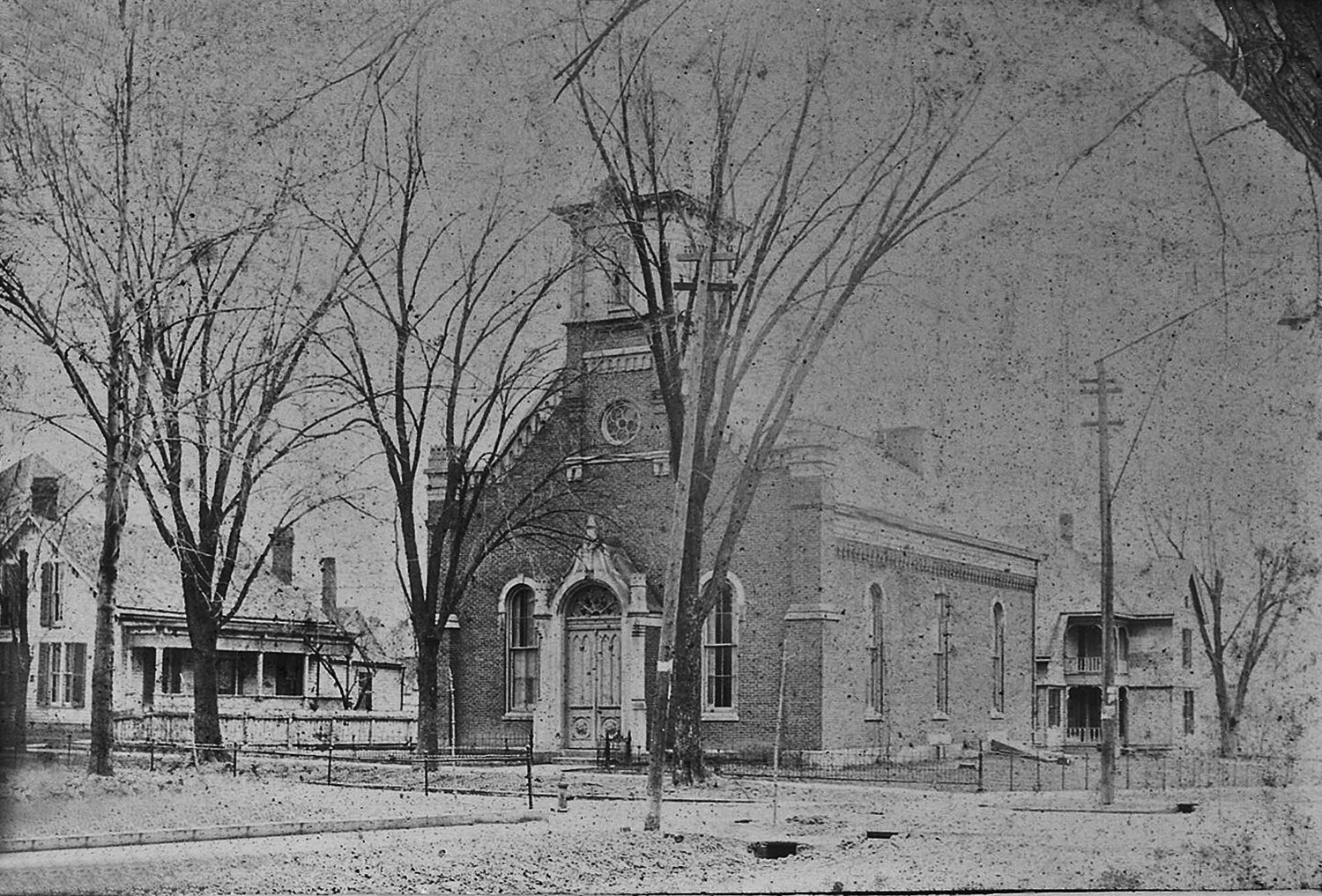Museum Corner September 2019
In August, Peggy Julian presented the 200-year history of the First Presbyterian Church in the county. In 1870, local builder, Thomas Stevens, replaced the church’s 1840 building with the new brick and stone building shown above. (Courtesy photo Lawrence County Museum)
Faith the common bond that built Palestine, BEDFORD?
By Becky Buher, Guest Columnist—Published in the Times Mail newspaper Sept. 4, 2019
About 200 years ago, located in what had previously been Indiana Territory, Native American lands were being vanquished by “new American” settlers.
In 1818, on a high bluff above the wooded banks of the east fork of White River, Lawrence County’s seat of government was being created. Robert Carlton, the county agent, promoted the 200-acre town named Palestine.
Newspapers in Salem, Madison and Louisville, Kentucky, advertised the sale of lots near a beautiful stream that would be worth the attention of enterprising men. There was opportunity for many of the first purchasers to make great profits on their investment in this newly platted town.
A two-story log “temporary” courthouse and a jail were built in 1818. Winston Cruise, dug a well on the public square, and Samuel F. Irwin and Isaac Stewart opened the first general merchandise store. In 1819, John Brown became the first postmaster. Joseph and Wier Glover built a tanyard.
The first county sheriff, Joseph Glover, brought the first clock into the county. Nathaniel Vaughn, because of his good moral character, was licensed to sell liquors and keep a house for public entertainment. Ezekiel Blackwell opened the first cabinet shop. Blackwell also operated a ferry across White River. Winthrop Foote was the first doctor. In the spring of 1819, the town had about 15 families living there.
They had arrived from Indiana counties to the south as well as eastern and southern states so most of Palestine’s new citizens had little in common. What would hold this diverse group of people together as a community? Could faith have become a common bond?
In 1819, Isaac Reed founded the Presbyterian Church in Palestine. He was one of the earliest ministers to come to Indiana. In the early 1800s, Reed worked with the American Home Mission Society and founded a number of Presbyterian churches in southern Indiana. The society’s mission was to provide ministers to areas west of the Appalachians.
Palestine continued to grow. About 1820, Rollin C. Dewey became the town’s first attorney. John and Samuel Lockhart built a large log house and installed a wool-carding mill. They carded on shares, and did the spinning of their share, which they kept for sale.
Samuel D. Bishop was hired to finish a brick and stone “permanent” courthouse and create private and public buildings. By 1822, the courthouse was finished. Plenty of lumber was available nearby in the poplar, oak and walnut hardwood forests. Game was plentiful. Flatboats were built and produce was moved by river from Palestine to markets in faraway New Orleans, Louisiana.
With 600 to 700 people in Palestine in the 1820 census, it was becoming a flourishing town.
However, trouble came to Palestine. People began to get sick. So many, that a petition was made to the Indiana Legislature and granted in February 1825 to relocate the county seat away from Palestine to a healthier location, which would become known as Bedford.
Some people moved away, but most traded their Palestine lots for the new town’s lots. Some disassembled their log or post and beam buildings and moved them to Bedford. One of these houses still exists today on 13th Street. These hearty souls helped to create the new “healthier” town of Bedford.
With the people, came their faith. The Lawrence County Seminary opened in 1832. By 1840, the Presbyterians had built a house of worship at 428 Sycamore (15th) Street in Bedford, and Solomon Kittridge was their first full-time pastor.
As Bedford grew, so did the faith community. By the end of the century within about a four-block area surrounding the courthouse square, people could find the African M.E. Church, Baptist Church, Catholic Church, Christian Church and Male and Female College, Church of Christ, German Methodist Episcopal Church, Methodist Church, Presbyterian Church and by 1905, the Episcopal Church.
This year, the First Presbyterian Church that was founded in Palestine is celebrating 200 years of service. Peggy Julian presented its fascinating history to an audience at the museum last month.
Every month the museum provides a stage for speakers to present interesting topics. Clay Stuckey will be speaking Sept. 9 at 7 p.m.
His presentation is “The Ku Klux Klan, D. C. Stephenson and the Murder of Madge Oberholtzer.” Interested? You are invited.

